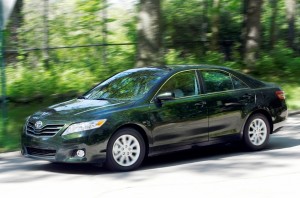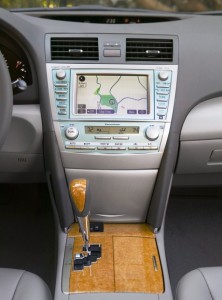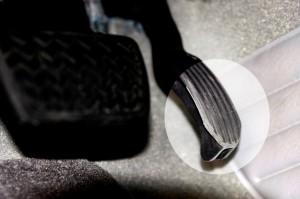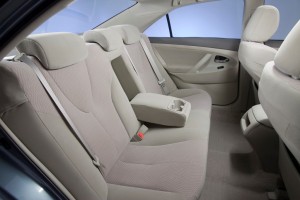The family sedan has gone soft during the past few years, as every entry in the segment has gotten larger, plusher, heavier and more expensive.
However, the addition of six or more airbags, vehicle stability control and elaborate electronic navigation and sound systems, among a growing list of features – all added weight and have worked against drivers by causing more frequent visits to the pump.
Increasing amounts of sophisticated technology, such as variable timing for engine valves, six-speed automatic transmissions and direct fuel injection have helped to keep the cars reasonably fuel efficient and – for the moment – out of gas guzzler tax range, but a balancing act is underway at competing makers.
The latest iteration of the Toyota Camry, introduced in 1997, is no exception. This sixth generation Camry is classified by the EPA as a midsize car with more than 116 cubic feet of passenger and trunk volume. (Camry was introduced in 1982 as a compact replacement for the Corona, and has been a growing car in the midsize class since 1992.) As the best-selling passenger car in the U.S. for eight years running, 12 of the past 13 years, Camry is the benchmark for the class. Through the end of April, Camry total sales are at 96,509, up 5.4% percent over this time last year.
Camry’s current prices range from $19,395 for the sedan with a new six-speed manual transmission to $29,245 for the XLE with a six-speed automatic transmission. The high mileage, low emissions Camry Hybrid carries a price of $26,400. (Add $750 for delivery.)
The top of the line XLE tested, totaled $31,475, although a shopper can likely do better than that – minus 5% to 10%, maybe more – given Toyota’s current use of incentives to regain momentum lost in the marketplace caused by the unintended acceleration recalls. This massive setback to Toyota’s heretofore good image has also caused Consumer Reports to suspend its long standing “recommended buy” on all Camry models, except for the hybrid, which is not affected.
Camry XLE comes with a 265 horsepower 3.5-liter DOHC six-cylinder engine with variable timing on intake valves, six-speed automatic transmission, vehicle stability and traction control. There are also: dual-zone automatic climate control with steering-wheel controls, a 440-watt JBL audio system with Bluetooth hands-free calling, heated leather seats, moon roof, power windows, locks and seats, and a navigation system: Going back only one generation for comparison, this Camry is really a Lexus luxury car with a Toyota badge.
If you could find one without the packages that include the navigation system and backup camera, and what I think is a ridiculous push button start system, heated seats and floor mats – then deduct $1,810, $890 and $200, respectively, or $2900, which brings the car down into the $28,000 range – before discounts. How much is a Lexus badge worth to you?
In comfort and quietness, this Camry is at the top of the class, and it is immediately apparent during all driving conditions. You can spend hours behind the wheel oblivious to the workings of the smooth V6 or the shifting of the transmission. You are also isolated from the outside world, listening to the commercial free satellite radio, unless a Ford diesel pickup truck pulls alongside and the obscene engine clatter overwhelms the complex horn of Miles Davis.
In ride and handling, the car is, well, dull or soft, lacking the steering responsiveness and body control of ride motions (and the harshness and head toss) of say a Honda Accord, but this is “dull” in a good way for a harassed commuter who doesn’t want to be aware or engaged with machinery.
At no time did I experience unintended acceleration; and the accelerator pedal had been trimmed to prevent floor mat entrapment. The aesthetics of the gray plastic accelerator with its cut edge a lighter, rougher gray look took away from the overall excellent interior finish. Toyota will give a new pedal to drivers who stare into their footwell when they become available as the recall is completed.
About the only surprise came from an electronic calibration issue, an issue that appears to be growing at all makers. The traction control on occasion worked at odds with the lowish front-wheel spring rates used on the strut suspension. On what I thought was a moderate launch in light rain, the front wheels began to hop as the engine torque overwhelmed the all season tires. Once started, the only way out of the ensuing harmonic bouncing and shudder was to lift off the throttle.
Ride settings optimized for all conditions are hard to work out. Put another way, the Camry is benign almost all of the time so that spinning, bouncing P215/60R16 tires come as a jarring reminder that there are only the rubber contact patches are between you and the road, no matter how much or what type of electronic controls are employed.
In mixed suburban and highway driving, I obtained 21 to 22 mpg on average, although official EPA ratings are 19 city, 28 highway. A better way to look it is figuring that you will use 3.3 gallons of regular unleaded gasoline for every 66 miles that click off on the electronic odometer under EPA’s worst case.
Camry is typical of family cars designed years before the global financial collapse in 2008 gutted American wealth, and collapsed the auto market. Camry was also planned before the new, higher fuel efficiency standards now taking hold. They require new cars to average 35.5 miles per gallon by 2016, a 30% increase.
If you are looking for fuel economy, the Camry Hybrid, equipped with Toyota’s extremely sophisticated Hybrid Synergy Drive (and certified as an Advanced Technology Partial Zero Emissions Vehicle or AT-PZEV), has EPA fuel economy estimates of 34 mpg highway, 33 mpg city and 34 mpg combined.
Camry’s exterior styling is mainstream, with a big snout, large grille, and sharp accent lines setting off curves that are more graceful – so much so that nary a person turned to look at the “spruce mica” or dark green sedan. Gold flakes in the dark green paint added a sparkling touch in direct sunlight, but otherwise this is a perfect sleeper during these days of increased police revenue raising due to diminished taxes, the direct result of the economic collapse caused by still unregulated Wall Street thievery.
Overall, there are good reasons why Camry has been such a strong sales success. It is a polite, unobtrusive, and up until now, an unquestioned “safe” buy in many senses. Trade-in values remain high, maintenance is minimal, and therefore overall cost of ownership is low. Since the nightly news and the Congress have turned attention to the BP oil spill disaster, Camry will fade from the headlines, but not from U.S. driveways. It is too good a car, with too many happy buyers not to remain a best seller.
What happens going forward to Camry, Chevrolet Malibu, Nissan Altima, Ford Fusion, Hyundai Sonata, among others — all mainstream entries at the heart of the U.S. market is not clear, but it is doubtful that they can grow much larger than the Honda Accord (technically now a full-size car with more than 120 cubic feet of volume and an overall length of 194 inches.) without leaving their buyers behind. Hyundai’s 2011 Sonata with its large volume of 120 cubic feet, but only 189 inches of overall length has caught the attention of competitive designers.
An emerging efficiency race is underway, as well, as hybrid versions or special fuel efficiency editions, such as the upcoming 40 mpg Chevrolet Cruze (it straddles the compact and midsize classifications), are added to the lineup of the leading contenders.
There is also the potential (in theory anyway) for the return of lighter, less plush 4-cylinder models. However, plans by automakers to sell smaller compact and even subcompact models for more than $20,000 (a big priced $22,000 but tiny Ford Fiesta this fall?) will put a squeeze on planners since it works against two vital corporate goals – the need to make money in a weak market; the need to become much more fuel-efficient by forcing smaller cars on U.S. drivers.




